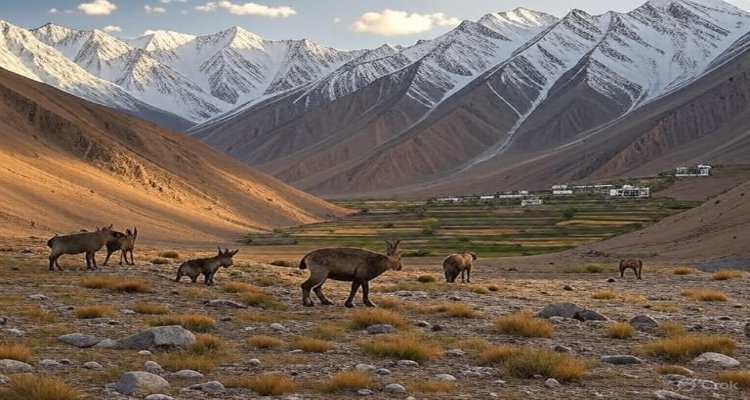India’s Cold Desert Added to UNESCO’s World Network of Biosphere Reserves
UNESCO adds India’s Cold Desert Biosphere Reserve to its global network, marking the country’s 13th site and a milestone for Himalayan conservation.
Introduction
High in the Himalayas, where barren mountains meet icy winds and snow leopards prowl across rugged slopes, India’s Cold Desert Cultural Landscape has now earned global recognition. UNESCO has officially designated it as part of the World Network of Biosphere Reserves (WNBR), a distinction that places it alongside some of the planet’s most critical ecological sites. With this, India’s tally of UNESCO biosphere reserves rises to 13, reinforcing its role in preserving fragile ecosystems at the intersection of culture, biodiversity, and climate resilience.
Context & Background
The announcement came during the 5th World Congress of Biosphere Reserves held in Hangzhou, China, from September 22–26. The gathering, attended by more than 2,000 global experts, Indigenous leaders, policymakers, and youth representatives, reviewed the progress of UNESCO’s Man and the Biosphere (MAB) Programme—an initiative that has guided ecological stewardship for half a century.
This year’s meeting was historic: UNESCO designated 26 new biosphere reserves across 21 countries, the highest addition in two decades. With these inclusions, the global network now encompasses 785 sites across 142 countries, covering more than one million square kilometers of protected natural landscapes since 2018.
For India, the recognition of the Cold Desert Biosphere Reserve underscores its ongoing commitment to harmonizing traditional practices with modern conservation science.
Main Developments
The Cold Desert Biosphere Reserve
Spanning 7,770 km² at elevations ranging from 3,300 to 6,600 meters, the Cold Desert Reserve stretches across Ladakh’s Leh and Kargil districts, Himachal Pradesh’s Spiti Valley in Lahaul-Spiti, and parts of Kinnaur. The region’s landscapes include glacial valleys, alpine lakes like Chandratal, the Pin Valley National Park, and wildlife-rich sanctuaries such as Kibber.
Despite its stark terrain, the reserve is teeming with life. It harbors 732 species of vascular plants, including dozens found nowhere else, and is home to iconic high-altitude wildlife such as the Snow Leopard, Himalayan Ibex, Blue Sheep, Himalayan Wolf, and the soaring Golden Eagle.
Equally significant are its human inhabitants—around 12,000 people who continue to practice traditional pastoralism, barley cultivation, Tibetan herbal medicine, and Buddhist-inspired resource management, blending ancient wisdom with survival in one of Earth’s harshest climates.
Expert Insight and Public Reaction
Environmental experts welcomed the designation as a critical step in bolstering conservation efforts.
“The Cold Desert is not only a fragile ecosystem but also a living cultural landscape. Its recognition by UNESCO will help attract international collaboration and resources for protecting biodiversity while safeguarding traditional knowledge systems,” said a Ladakh-based conservation scientist.
Local voices highlight the cultural significance. A village elder from Spiti noted, “For generations, our lives have depended on respecting the land. This recognition tells the world that our traditions are a form of conservation.”
Impact & Implications
The Cold Desert’s inclusion brings multiple implications:
- Global Recognition – As part of the WNBR, the region will benefit from international research partnerships, ecological monitoring, and policy support.
- Climate Resilience – The cold desert ecosystem, one of the driest and coldest, offers critical insights into climate adaptation, water conservation, and sustainable agriculture in high-altitude settings.
- Cultural Preservation – By integrating Indigenous practices and Buddhist ecological ethics, the biosphere model ensures that cultural heritage remains central to conservation.
- Tourism and Livelihoods – Recognition may boost eco-tourism opportunities, offering economic benefits to local communities while encouraging sustainable visitor practices.
- India’s Global Standing – With 13 biosphere reserves under UNESCO, India strengthens its role as a key player in biodiversity conservation and sustainable development.
Biosphere Reserves: Learning Places for the Planet
UNESCO describes biosphere reserves as “learning places for sustainable development.” Each reserve integrates three main functions:
- Conservation of biodiversity and cultural heritage.
- Sustainable Development that balances livelihoods with ecological limits.
- Logistic Support through research, monitoring, and education.
To achieve these goals, biosphere reserves are structured into three zones:
- Core Area: Strictly protected ecosystems.
- Buffer Zone: Surrounding areas for ecological research and limited human activity.
- Transition Zone: Regions where communities engage in sustainable practices.
Globally, around 275 million people live in biosphere reserves, demonstrating their dual role as human habitats and conservation strongholds.
India’s Growing Network of UNESCO Biosphere Reserves
With the Cold Desert’s addition, India now has 13 UNESCO-recognized biosphere reserves. These include:
- Nilgiri
- Gulf of Mannar
- Sundarbans
- Nanda Devi
- Nokrek
- Pachmarhi
- Similipal
- Achanakmar–Amarkantak
- Great Nicobar
- Agasthyamala
- Khangchendzonga
- Panna
- Cold Desert Cultural Landscape
Together, they represent India’s diverse ecosystems—from coastal mangroves and tropical forests to alpine peaks and now, the cold desert.
Conclusion
The inclusion of India’s Cold Desert into UNESCO’s World Network of Biosphere Reserves is more than a symbolic honor—it is a global acknowledgment of the delicate balance between nature and culture in the Himalayas. At a time when the world is grappling with biodiversity loss and climate change, this recognition strengthens the case for local-global partnerships rooted in sustainability.
As the Man and the Biosphere Programme enters its next decade, India’s cold desert will stand as a beacon of resilience, offering lessons on how ancient traditions and modern science can work together to safeguard our shared future.
Disclaimer :This article is for informational purposes only. It is based on UNESCO’s official announcements and contextual research on biosphere reserves.











